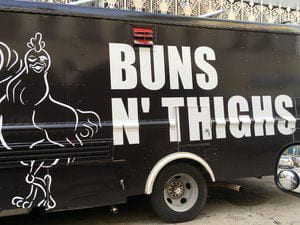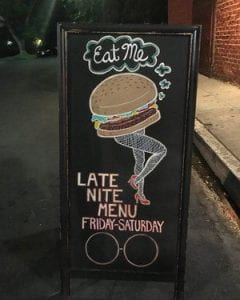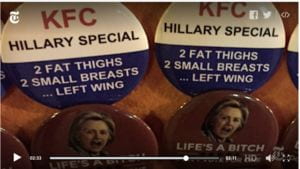The sexualized depictions of food and meat groups together women and animals Women “want it” and therefore so do animals. Women and animals are grouped together as “others” who are deemed to be for the consumption of the white male. In this post I will be analyzing four images in reflection to Carol Adams, the author of The Pornagraphy of Meat and The War on Compassion. Adams teaches that women, people of color, and animals are grouped together as these “others” in a way that enables the mistreatment of groups of people throughout history that have experienced genocide and violence.
 Image 1 This image depicts a chicken walking and winking with the words “Buns n’ thighs” emblazoned beside it. The image of the chicken sexualizes the animal in the way that images of women are sexualized. Because women are seen to “want it” and deserve the violence that is sent their way, so is the chicken seen in the same manner (Kemmerer).
Image 1 This image depicts a chicken walking and winking with the words “Buns n’ thighs” emblazoned beside it. The image of the chicken sexualizes the animal in the way that images of women are sexualized. Because women are seen to “want it” and deserve the violence that is sent their way, so is the chicken seen in the same manner (Kemmerer).
 Image 2 This image is an even more blatant example of what we saw in the first image. The Burger is given a woman’s legs, dressed in fishnets and red heels. Wearing accessories such as this is generally how the media classifies a woman as being “easy” or “slutty”. The burger is telling the viewer to “eat me” so here we are focusing on Adams point even further that by sexualizing meat, we are saying that just as women “ask for it” so do animals.
Image 2 This image is an even more blatant example of what we saw in the first image. The Burger is given a woman’s legs, dressed in fishnets and red heels. Wearing accessories such as this is generally how the media classifies a woman as being “easy” or “slutty”. The burger is telling the viewer to “eat me” so here we are focusing on Adams point even further that by sexualizing meat, we are saying that just as women “ask for it” so do animals.
 Image 3 Here we see the opposite happening from what happened in the above images. On these pins the designer is looking to dehumanize Hillary Clinton by describing her the way KFC it’s chicken. Therefore reducing her humanity to the viewer, legitimizing negative treatment of her (Adams).
Image 3 Here we see the opposite happening from what happened in the above images. On these pins the designer is looking to dehumanize Hillary Clinton by describing her the way KFC it’s chicken. Therefore reducing her humanity to the viewer, legitimizing negative treatment of her (Adams).
 Image 4 Here we see another example of Adams’ concept of “anthropornagraphy” or the “depiction of nonhuman animals as whores” (Adams). This is just a further example showing that the animal “wants it” and is asking for the public to subject it to violence.
Image 4 Here we see another example of Adams’ concept of “anthropornagraphy” or the “depiction of nonhuman animals as whores” (Adams). This is just a further example showing that the animal “wants it” and is asking for the public to subject it to violence.
Works Cited

Kiera
I’m commenting on your first paragraph – “women and animals are grouped together…” This sad truth of ecofeminist concerns has also become a concern of mine because of the environmental effects. I never saw the consumption of meat to be so wrong until recently when I was looking for a movie on Netflix and came across a documentary called “Cowspiracy”. For some reason, this documentary resonated with me, and although I continued eating meat, it became less and less appetizing to me. Now meat as well as meat products is scarce in my diet. But what is even more disturbing (and “Cowspiracy” pointed out) is that we are destroying ourselves just by eating meat because of the rippled effects of environmental degradation. This has to do, not just with the exploitation of women and animals but it also affects our natural resources (trees, wildlife, water, etc). Fast forward to this class and this week’s topic (and last), and I feel that this is another example of how we are imploding, and it is very scary. Adams helps us understand this concept in her interview (below), by pointing out that “animalizing protein” destroys the environment.
“Feminist-vegan theory is ecofeminist, that is, environmental issues can’t be understood without a feminist perspective and feminist issues can’t be understood without an environmental perspective. I place animals into the middle of this insight. As an ecofeminist theory, it recognizes the environmental costs of animalizing protein. Meat production contributes to water pollution, climate change, habit fragmentation, and desertification of arable land. All protein is from plants; animalized protein requires that a living animal process the protein and then be killed” (Adams, 13).
Hello!
Image 4, I think is interesting. Although the image of the chicken I agree can be related to anthropornogrphy, or human female bondage because of the human/animal suggestions. I looked up why people truss the chicken and there was one article that stood out who wanted to see the difference of a trussed vs. non trussed roasted chicken. Apparently the chicken is trussed so that it cooks more evenly but also so that it looks attractive?!?!? Anyway, the article did seem to confirm that trussing the chicken kept it juicer.
https://www.fifteenspatulas.com/should-you-truss-a-chicken-or-not/
Hello, I agree that women and animals have been mistreated in the past and therefore remain as a group, as one and to some as equals. It is unfortunate that we have outgrown he mistreatment in one way, yet still experience it in day to day lives when we;re just mining our business. A simple advertisement can strike our eye, and not in the sense of us wanting to invest in that item.. but because it can be offensive. Today most men are still he heads of major companies in the industry and call the shots on what goes to represent that brand, I do believe that us women are so used to seeing this and being exposed to it that not many of us have thought of fighting it.
Hello Kiera,
your last image of the chicken tied up doesn’t seem to me like the chicken “wants it”, it looks more like force and violence. I understand the concept of “wanting it” in your other images where the women and animals look provocative, but the last one is different. You mentioned that the chicken is asking for violence, but I’m looking at it from another perspective. What I mean is that, from what I understood, the images of women and animals acting provocative are the ones that suggest that they “want it”, but this one seems like straight up force and violence. I also noticed one of the pins with Hillary’s face that says “Life’s a Bitch” which is also associated with non-human animals because a bitch is a female dog as we all know and women are often referred to as bitches. Overall, I agree with your interpretations of these images. Also, I remember I took a class on food being used as luxury and for social gatherings and I think this applies in this case because the majority of those ads are trying to get people to buy their food by making it look desirable. People have forgotten that food is a human necessity and it doesn’t need to be shown as a luxury item to attract people. This also drives people to obesity and other things because we eat with our eyes. We might not even be hungry, but these ads make food look so desirable that we want it.